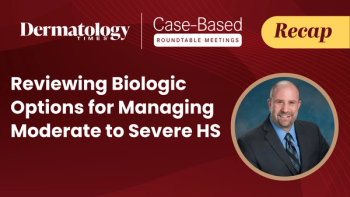
Novel actinic keratoses compound treats lesions faster
Omaha, Neb. - A new treatment for actinic keratoses, known as PEP005, has completed two phase 3 trials which demonstrated that ingenol mebutate gel 0.05 percent, when used to treat actinic keratoses (AK) on the head and non-head locations, resulted in complete clearance of the lesions, when compared to vehicle.
Key Points
Revised: June 24, 2010
The findings were presented at the 68th annual meeting of the American Academy of Dermatology, and the findings suggest the prospect of another therapeutic option to treat AKs, according to Joel Schlessinger, M.D., F.A.A.D., F.A.A.C.S., a board-certified dermatologist and cosmetic surgeon, president emeritus, American Society of Cosmetic Dermatology and Aesthetic Surgery, and president,
Leo Pharma hopes to file for FDA approval by mid 2011 for PEP005 as a treatment for actinic keratoses, according to Dave Domzalski, vice president of marketing and sales.
"The Peplin (Leo Pharma) product will represent another entrant into this category," Dr. Schlessinger says. The once-daily application for two consecutive days "represents a simpler process for those individuals who are looking for treatment of AKs. The benefits of a short application or limited application are not to be understated. It will be interesting to see when and how the market will change when and if it will be approved by the FDA. (The product) provides a compelling case for efficacy and safety."
Promising therapy
The standard therapy for treating AKs has been liquid nitrogen, but it cannot act as a field therapy that can clear subclinical lesions, whereas PEP005 has the ability to act as a field therapy, Dr. Schlessinger explains. Moreover, clinicians who use cryotherapy and use a prolonged application of liquid nitrogen may find it triggers pain in patients and can result in hypopigmentation.
AKs are precancerous lesions. If left untreated, they can develop into squamous cell carcinoma. According to the American Academy of Dermatology, about 40 percent of squamous cell cancers begin as AKs.
PEP005 is a topical gel containing ingenol 3-angelate, a molecule derived from the sap of a common garden weed called the petty spurge, used as a traditional medicine in many countries for skin conditions. Ingenol 3-angelate triggers protein kinase C, which mediates various cellular processes. Phase 2 trials showed application of the gel after two days resulted in the disappearance of 71 percent to 75 percent of lesions. Patients reported mild adverse events, such as redness and peeling.
Results from the phase 3 REGION-Ib trial demonstrated that treatment with PEP005 0.05 percent gel once daily for two consecutive days in 117 patients on non-head locations resulted in significant clearance of AK lesions when compared to vehicle (n=118).
Specifically, the study showed a 66.7 percent median decrease in the number of AK lesions when compared to placebo that was statistically significant, and a rate of complete clearance of 42 percent (ITT), including 16.0 percent, back of hand, and 25.3 percent, arm locations. The phase 3REGION-IIB trial looked at the impact of PEP005 0.015 percent gel, oncedaily for three consecutive days, on head locations, which demonstrated acomplete clearance rate of 47.2 percent.
Local skin responses consisted of erythema and flaking/scaling. The most common adverse events were site irritation and pruritus. A total of seven patients in the treatment group reported having pigmentation changes.
"The holy grail has been that the product is not only effective, but that it is easy and understandable for people to use," Dr. Schlessinger says. "What is out there is close to that, but not there yet, so this compound offers a potential option, if it is approved."
Room for improvement
The efficacy of the compound in treating other conditions is being explored for the future, Dr. Schlessinger says. "There still isn't a 'slam dunk' product to topically treat superficial basal cell carcinomas," he says. "That may be one avenue to consider in the future."
In addition to the anticipated PEP005, a "kinder, gentler" form of imiquimod is poised to enter the competitive marketplace of AK therapies, Dr. Schlessinger notes.
"It yields the same result with a less vigorous process," he says. "It will provide an alternative for people who are looking for a less aggressive, but effective, product for the treatment of actinic keratoses."
Another exciting prospect is the entrance of genericized versions of imiquimod into the marketplace. The therapy has been successful, but it is a pricey product, according to Dr. Schlessinger.
"There will be less expensive alternatives available for patients," he says.
Disclosures: Dr. Schlessinger is an investigator for Leo Pharma and for Graceway Pharmaceuticals.
Newsletter
Like what you’re reading? Subscribe to Dermatology Times for weekly updates on therapies, innovations, and real-world practice tips.


















